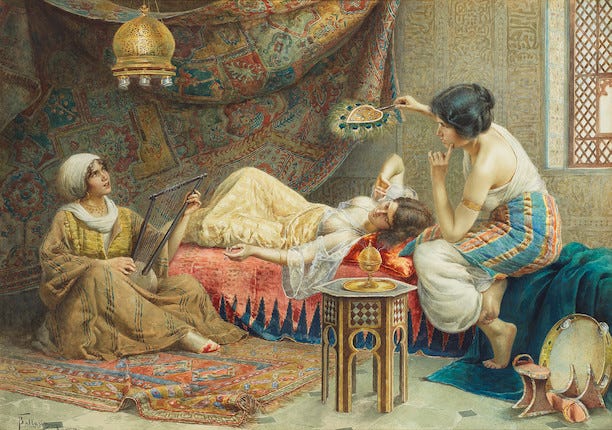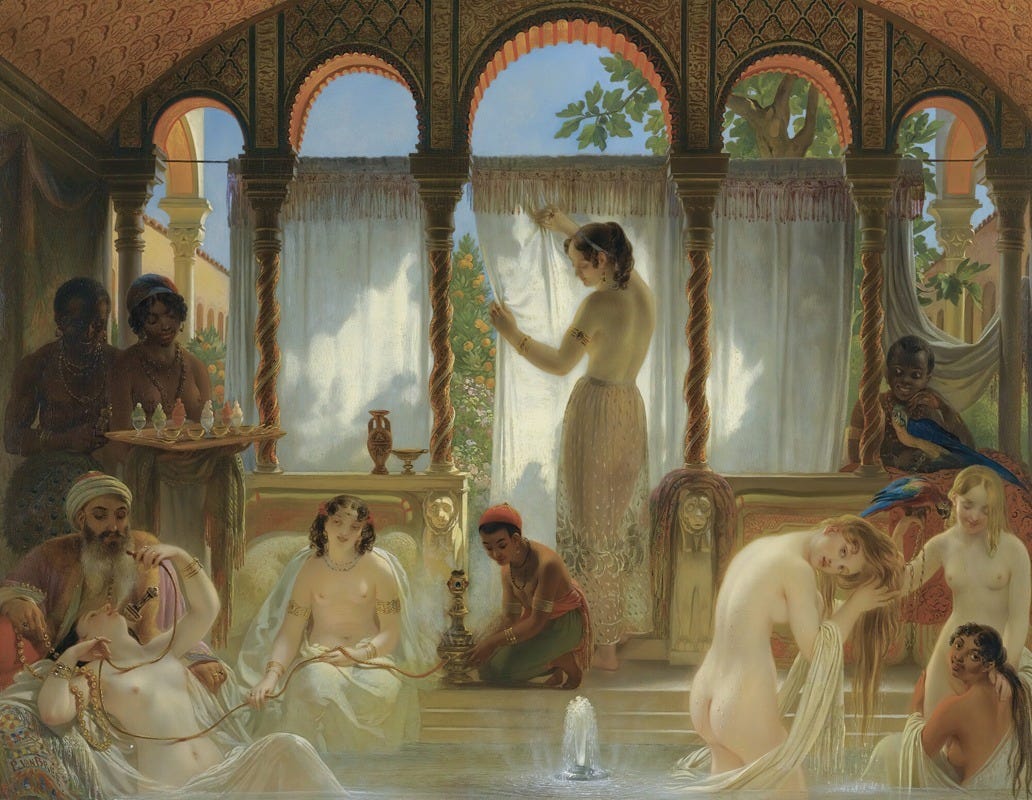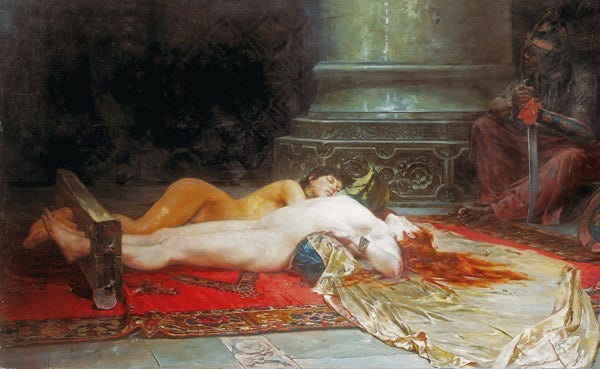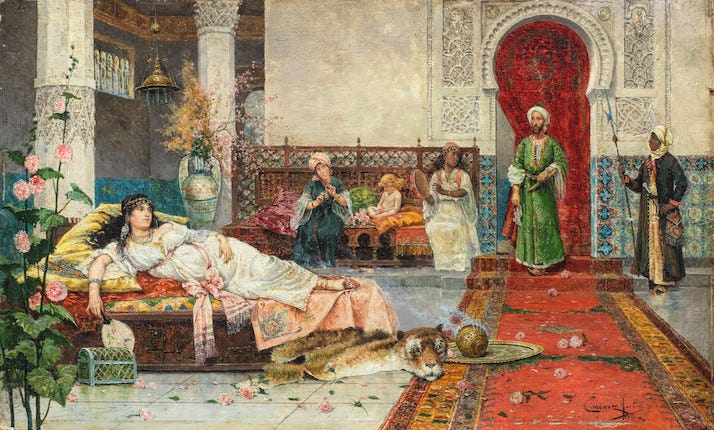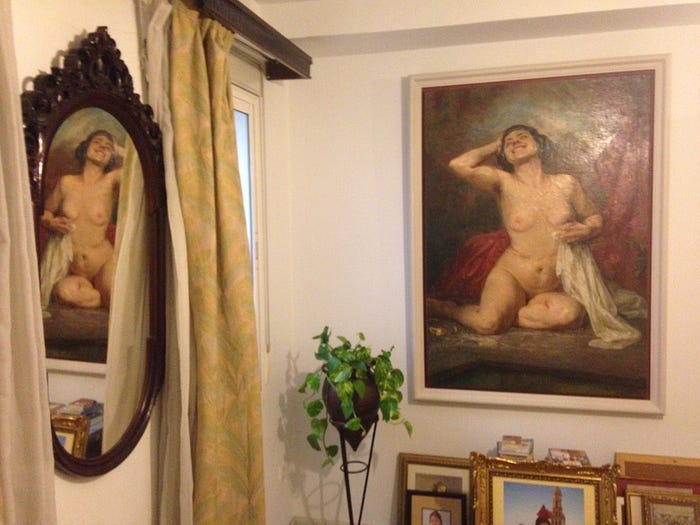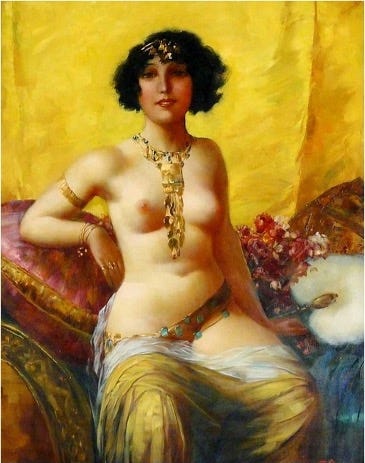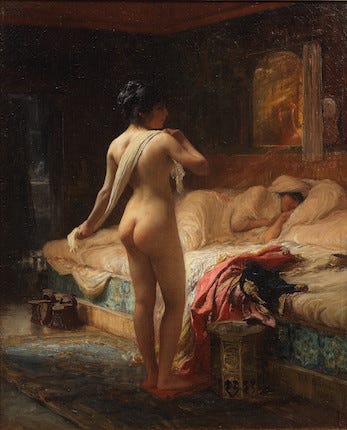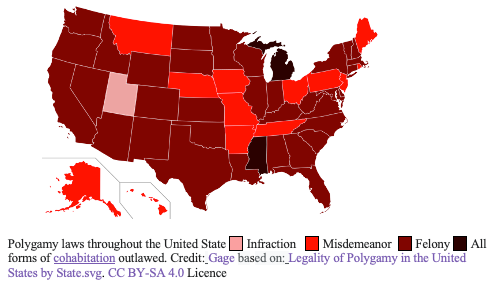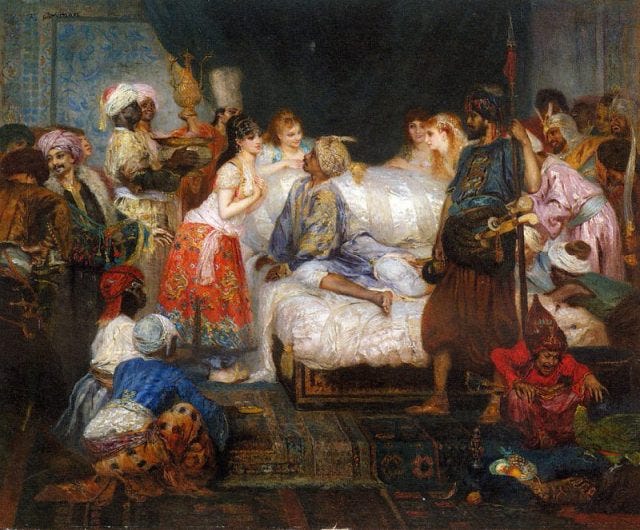This is Chapter Three in the beta-reader serialization of The Sexualization of Islam, a 13-part, nonfiction enquiry into how Western ideas of the Orient, and Islam in particular, were shaped by artists’ visions of the erotic and exotic.
For the Prologue to this series, please click here. For Chapter One (The Orientalists), click here. For Chapter 2 (The Slave Market), click here.
“Except you enthrall me, never shall I be free,
Nor ever chaste, except you ravish me…” – John Donne
ACCORDING TO THE JERUSALEM POST (what better source of unbiased information on Muslim life and customs?), the Arab world did not recognize the word “harem” until the late 14th century, that is, not until after dictionaries of the Arabic language were developed.[1] The timing coincided with Johannes Gutenberg’s invention of the printing press and development of movable type around 1439 CE which contributed to the distribution of information about the Orient. The spread of sometimes accurate, sometimes inaccurate, information began with the Ottoman Turks labelling their place of confinement for women and concubines as the “harem-lik.”
The Italian word “seraglio,” is used interchangeably with the word “harem” and derives from the Late Medieval Latin word “serraculum,” meaning “enclosure.” Seraglio came into the English lexicon around 1512 as a synonym referring to the abode of the wives and concubines of the Ottoman Empire.
“Each sex seemed to know its place and acted accordingly, the man dominant and even cruel, if necessary, the woman always receptive and resigned” – Joan Del Plato [2]
The rigidly controlled and heavily guarded harem/seraglio has always been off-limits to outsiders, especially non-Muslim painters, while access was limited to the master, his captive women, and their asexual eunuchs. Here the Western-oriented viewer wanders without a compass, taking the artist’s message at face value. He or she imagines themself in the role of Pasha or perhaps his voluptuous favourite.
Both Phillipe-Jacques Van Bree’s and Jean Leon Gerome’s paintings suggest an insider’s view of an Ottoman Sultan’s harem. The inmates are all white skinned while their attendants all Black, although very little was known of the actual racial makeup or demographics of Turkish, Middle Eastern, and Persian harems except that they consisted almost entirely of kidnapped or purchased sex slaves. While most inmates functioned as mere flesh and were disposed of when aged, diseased, or fallen out of favour, the mother of a sultan or someone who’d given birth to the son of a powerful master, though she may have been a slave herself, could rise to high status. Think prisoner committee leaders in maximum security prisons.
In Istanbul, it was the mother of the Sultan who made all decisions regarding the harem and sometimes exerted a measure of influence in matters of state. In effect, the explosive growth of the harem as an institution had a powerful effect on the traditionally dismal status of women under Islam, allowing some to rise in the dynastic power structure, while most lived a largely unfulfilling, fit-for-purpose life. Women past their prime who had not produced offspring were often dismissed from the harem to take up other household duties, sold to new masters, or tossed into the street, thereby facing an even bleaker reality.
The often-made claim that harem inmates were far better off than most other women of their day should be taken with a large grain of salt. Their so-called education was confined to recitations of the Quran, although most remained illiterate. There was no access to news of the outside world or the families and loved ones from whom they were forcibly separated. The harem was a life sentence earned by having been born beautiful and sexually desirable in a geographic location or society that was vulnerable to slave raiding. Balkan and Circassian women were especially prized for their light eyes and skin while the Quran permitted enslavement of the darker, non-Muslim Mediterranean women who partook of the North African paradigm of beauty. Any non-Muslim woman or girl, married or otherwise and regardless of age, fell prey to their lustful designs.
By the mid-16th century, armies of the Ottoman Empire had besieged the gates of Vienna. Sex slave taking of light-skinned European women was in its heyday. Vienna was poised to become the motherlode of blond, blue-eyed, light skinned women, the very reason that Muhammed himself had exhorted his followers to conquer Byzantium (i.e., the Eastern Roman Empire) back in the seventh century.
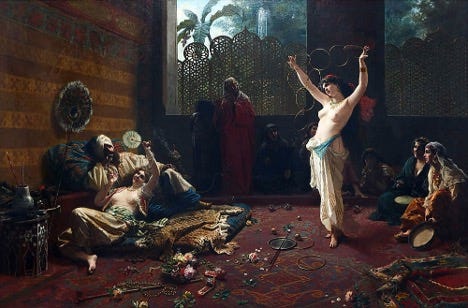
Harem security was generally better than that of most banks, thanks to the vigilance of the mostly Black eunuchs. While Islamic law forbade the emasculation of a man (Sunan na-Nasai. Hadith 4736), Ethiopian Christians had no such reservations. They reportedly enslaved and emasculated male children from the African Great Lakes region and other areas in Sudan such as Darfur and Kordofanand, selling the resultant product to anyone in the market for a male servant incapable of sexual intercourse. While the Vatican stubbornly backed the trade of Black Africans into the Americas, the Coptic Orthodox Church specialized in the castration of male children and the slave trading in eunuchs.
Like the Greek, Russian, and other Orthodox sects, Copts are Catholics who do not recognize the Pope as their titular head. Coptic priests sliced both penis and testicles off captive boys at around the age of eight, a barbaric procedure given the lack of anaesthetics and general uncleanliness of the day. The recovery rate is said to have been around ten percent; that is, for every 100 castrated, only ten survived. Most are reported to have endured castration at the Abou Gerbe monastery on Mount Ghebel Eter.
Judging from popular literature, which appears to be a chain of publications beginning with Edmund Andrews’ 1898 article entitled “Oriental Eunuchs” and Peter Charles Remondino’s follow-up book entitled “History of Circumcision from Earliest Times to the Present,” published in 1900, through to a 1919 article by Henry G. Spooner in the American Journal of Urology and Sexology, each succeeding author has borrowed from and embroidered upon information gleaned from earlier works. None had actually “been there, done that.” The big number is put at 35,000 successful castrations. At a 90 percent attrition rate, the gross throughput for castration mills such as Abou Gerbe would have to have reached around 3.5 million children. Hardly believable; nonetheless, the presence and critical role played by eunuchs throughout North Africa, Turkey, the Middle East, and Persia (today’s Iran) is indisputable.
During the same era, barber surgeons in Italy were castrating some 2,000 male children each year to provide feedstock for singing academies that supplied “castrati” to church choirs and opera houses. Most of these spandini, however, ended up working in the sex trade until the practice was outlawed after annexation of the Papal States by the Italian government in 1870. Sexual relations with these early transexuals was deemed “Il peccato nobile,” or the noble sin. Many remained capable of achieving erections and were in demand by discerning, well-heeled women wishing to avoid impregnation.
Handel composed music for the castrato voice. Curiously, the last role ever written for a castrato was that of Armando in Giacomo Meyebeer’s opera “Il Crociato in Egitto (The Crusader in Egypt).” Once again, the paths of East and West intersect in art.
Muslim society has never excelled at record keeping, at least when it comes to matters of no real importance to themselves. The process of castration for eunuchs more likely resembled that employed by Italian barber surgeons (my grandfather [1876-1973] was an old-time barber surgeon, although to my knowledge he cut hair, not testicles), the product of which can still be heard in early 20th century recordings. Furthermore, the castrations were likely to have been performed locally as I could not find any reference to the Abou Gerbe Monastery or the location for Mount Ghebel Eter.
Middle Earth, maybe?
For the S&M crowd, there is Eisenhut’s “Before the Punishment.” Here is a juxtaposition of a white woman with a woman of colour guarded by a Black eunuch.
Given the multiple layers of security in Ottoman and North African harems, attempts at escape were seemingly rare. Whatever the backstory, Eisenhut invites the viewer to feast on fettered voluptuousness juxtaposed with the defenseless availability of the goods on display. The master was expected to discipline his female merchandise and was entitled to kill them without repercussions.
If Orientalist painters are to be believed, then harem life must have been extraordinarily boring. One does not find books or other signs of intellectual stimulation in these tableaux, although caged birds, musical instruments, and pottery vessels symbolic of the womb and its role in reproduction are sometimes evident. A fidgety or troublesome harem inmate who failed to entertain or please her master would be sold or traded for a younger, more compliant, better skilled substitute. Then as now, a man demanded value for money.
It can be expected that not all women captured and sold as sex slaves accepted their fate quietly. From an original eyewitness account first published in 1693 (currently out of print):
The Barbary corsairs once plundered a British ship headed for Barbados; they took the crew captive and brought it to Moulay Ismael’s palace. Among the captives were four women, one of them virgin. This delighted the Sultan who tempted her to give up her Christian faith “with promises of great rewards if she would turn Moor and lie with him,” noted the British captive, Francis Brooks. Her refusal enraged the Sultan who “caused her to be stript and whipt (sic) by his eunuchs with small cords so long till she lay for dead.” He then instructed to take her away and fed nothing but rotten bread. Eventually, the poor girl had no option but to “resign her body to him, though her heart was otherwise inclined.” The Sultan had her washed and clothed…and lay with her. Once his desire was sated, he inhumanely, in great haste, forced her away, out of his presence,” added Brooks.[3]

Ingres’ “The Turkish Bath” depicts a gathering of stark naked, mostly blue-eyed and blond-haired, mature white women. There are no Black sex slaves in the harem, women of colour being assigned to servile roles, although it would be unrealistic to insist that the masters did not also bonk the hired or otherwise enslaved help. It was a custom in slave owning households throughout the American South and among the English upper classes, so why not Arabia? As actress Peggy Maley’s character wryly observed in the movie “Human Desire”:
“Women are all alike. They just have different faces so that men can tell them apart.”
Another curious aspect of Ingres’ painting is the absence of pubic or underarm hair on his subjects, another European constraint. Adding pubic hair would have made the painting obscene, even in the context of Orientalism, and attracted attention from the morals police. Check out any of the many Odalisques of the period: no evidence of any pubic hair. Or is this merely an allusion to men’s attraction to prepubescent girls?
The viewer will find no depiction of naked prepubescent girls throughout the vast body of Orientalist painting, despite many references in the Quran, hadiths, and safirs. Again, the Orientalist painter shoehorned a Western value system into an Oriental template, emphasizing the most attractive aspects – to the Western mind, at least – and ignoring the unpalatable or repugnant.
Here is a more upbeat image from my collection by Jose Jimenez Aranda’s student, Gonzalo Bilbao Martinez, depicting a scene from Andalusia’s harem baths. Islam dominated southern Spain for 700 years, before the last Muslim stronghold (Granada) fell to the Catholic monarchs, Ferdinand and Isabel, in 1492.
These images of voluptuousness projected by Orientalist painters would later be challenged by more sober and even revulsive imagery produced by native photographers who took up the camera after its invention in the 1830s. Nonetheless, for almost two centuries, Western audiences were treated to a practically beatific vision of Oriental womanhood and the wonders of the seraglio, what the fictional painter Gustavo Naranjo in my historical fiction novel “Niña Desnuda (The Naked Girl)” calls the “geografia imaginaria.”
“Well, back in the last century when Garcia Ramos and I boarded the ferry together at Tarifa for our junket to Morocco and Algiers with rucksacks on our shoulders and dragging our cardboard suitcases filled with paint tubes and brushes and our folding easels, we were headed toward a ‘geografía imaginaria,’ determined to create ‘ambiente.’ Our inspiration and idol, Mariano Fortuny, did the same. It was a trend, you see. We set ourselves up in the bazaars of Marrakesh to sketch, then afterwards assembled these colourful characters into allegorical settings that expressed a rich vision of exoticism and eroticism and dark intrigues, a world in which the imagination ran wild.”
“If the painter wishes to see beauties that charm him, it lies in his power to create them, and if he wishes to see monstrosities that are frightful or buffoonish or ridiculous or pitiable…he can be lord and master thereof.” – Leonardo DaVinci

In the visual arts, storytelling mostly takes place in the mind of the viewer. Like an author starts a book while a reader finishes it, painters provide setting and create ambience while viewers conjure up the storyline and experience the emotional journey.
“Aprés Le Bain” is a painting by Frederick Arthur Bridgman (1847-1928) on the much-repeated bathing theme, but this time more complex, somber, and pregnant with allusion. The isolation, loneliness, and dearth of hope for a sex slave is expressed in the artists’ choice of lighting, colouration, and the positioning of figures and props. More than just an erotically charged picture, lesbian overtones in this work are impossible to ignore.
Bridgman’s subject has been bathed and groomed for sex, leaving the viewer to decide whether the subsequent encounter will be with another woman or involve a female-male-female (FMF) threesome when the master arrives at the bed chamber. Note the artist’s provocative use of rose in the buttocks of the standing figure. A red silken gown and jewelry tossed carelessly aside complete the dynamic triangle. If the viewer could step into this painting, then what might be their role?

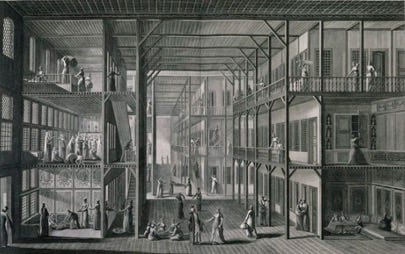
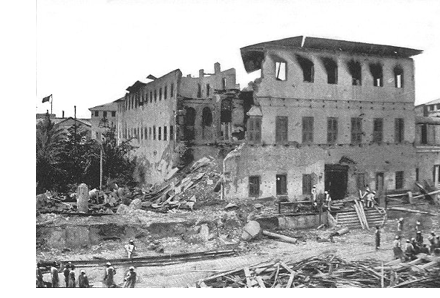
The grand seraglio of the Ottoman Empire is the best known and perhaps most politically complex, although not history’s largest, collection of captive women. The harem edifice itself comprised some 400 bedchambers and employed over 600 eunuchs serving hundreds of concubines, most of whom derived from the Caucasus or the Barbary slave markets.
The harem of Ismail ibn Sharif (1672-1727) who ruled Morocco during the heyday of Barbary piracy (16th to 19thcenturies), housed over 500 concubines. Ismail ibn Sharif holds the distinction of having fathered over 800 offspring, more than anyone in recorded history. Like other Muslim rulers and some Islamic terrorist leaders today, he claimed descendance from Muhammed through his roots to Hassan ibn Ali, a grandson of the prophet.
As Islam spread into South Asia and Indonesia after the seventh century, mass enslavement of women followed. The harem of Sultan Ghiyas-ud-Din Kilji (1460-1500) is said to have numbered over fifteen thousand and required a separate walled city of women and eunuchs. He is believed to have been poisoned by his son and successor.
Augmenting the sexual consumerism practiced by the sultans, many thousands of lesser nobles and householders maintained large harems that drew heavily on the trade in light-skinned European-born women. The institution flourished into the 20th century and featured prominently in the Armenian genocide perpetrated by the Turks during the First World War. As practiced by ISIS and other contemporary Islamist terror groups, a young woman’s conversion to Islam and submission to sexual exploitation by Turkish soldiers was her only path to survival.
The Quran, Hebrew scripture, and Western artworks all confirm that sexual slavery and the general abuse of women has been central to life in North Africa, the Arabian Peninsula, the Levant, and the Middle East, pretty much throughout recorded history. Sumerians, Babylonians, Canaanites, Israelites, and other local civilizations institutionalized the harem although calling it by a different name. When a man keeps several legal wives and a few sex slaves in his household, what would you call it?
Americans call it polygamy and, while the practice is illegal in all 50 states, it goes unprosecuted since all female cohabitants additional to the first legal wife are considered wives only in the context of religious beliefs. Freedom of religion is guaranteed under the United States Constitution. Unlike Islamic countries, sex acts performed by consenting adults of any gender go unpunished in the USA, but the underlying principle is the same. If an American wants a harem, he can have one. He can even have a sex slave, although a signed and sealed sexual consent form thoroughly vetted by one’s legal counsel is highly recommended.

Do Orientalist harems exist in the world today? The answer is a resounding “YES!”
King Mswati III is the absolute monarch of Swaziland with some 15 wives. Unlike the oil-rich Saudis or the Brunei royals, his annual family budget is a modest $61 million in a country where many are starving. His father had 125 wives. Both are accused of having kidnapped women for their harems. King Mswati III is reportedly a Christian monarch.
According to Swazi custom, the 45-year-old king may choose a new bride every year. To date, he has sired some 27 children. Meanwhile, his sixth wife fled the royal harem, citing years of "emotional and physical abuse," and his latest love interest, 15-year-old Tintswalo Ngobeni, has fled to Britain, claiming political asylum. On the brighter side, billionaire King Mswati III sends all his wives to America each year, armed with a generous shopping allowance.
The late Saudi businessman and arms trader Adnan Khashoggi is alleged to have kept at least 11 “pleasure wives” at any given time. These women had more in common with Eduard Manet’s “Olympia,” that is, high priced courtesans, than the usual Orientalist depiction of a harem inmate. Khashoggi’s was representative of a type of modern harem comprised of gold diggers forming around rich and powerful men. Like bees around honey, these so-called harem inmates are held captive by addiction to expensive gifts and a lavish lifestyle instead of Black eunuchs brandishing scimitars and spears.
Countless numbers of Western women have succumbed to the charms of Muslim men who, financed by their wealthy families or fueled by scholarships and grants from Western endowments and universities, study or live outside Muslim-ruled countries. To quote an overused slogan: “One can take the Muslim out of Islam, but they can never take Islam out of the Muslim.”
The experience of feminist author Phyliss Chesler, Jewish-American professor emeritus of psychology and women’s studies at City University of New York, is a case in point. At age 20, in 1959, she met and married Afghani-born student Abdul-Kareem while both studied economics at Bard College.
Assuring her that they would honeymoon in Europe with a brief side trip to visit his family in Kabul, she soon found herself locked inside a Muslim harem. While her newlywed husband so far had only one wife, his father had four who proceeded to Islam-ize Phyliss and beat her to the point where her life became endangered. Her later recounting of the experience won the National Jewish Book Award.
It would be naïve to assume that hers is an isolated case but read about it here and form your own conclusions.[4]
“I am bored, so bored!”- Phyliss Chesler
The tiny Asian nation of Brunei, where the royal harem is alive and well, is the first Asian country to adopt and implement Sharia Law. Sentences that include stonings, amputations, and hanging from construction cranes reflect the current spread of Arab culture among non-Arab Muslim states. As always, the penalty for gay sex is death. Garden variety adulterers are whipped or, in the case of women, buried up to their necks then stoned to death.
Political pundits are scratching their heads in dismay. Brunei is the size of the U.S. State of Delaware with a population of 415,000, not a big number by any measure. Nonetheless, Brunei is the fifth-richest nation on Earth. The sudden shift to Sharia in this former British protectorate was obviously not triggered by religious devotion as the Sultan himself and his entire family have violated practically every Sharia rule.
A 2011 Vanity Fair article called the Sultan and his brother, Prince Jefri, “companions in hedonism.”[5] Perhaps the royal advisers have determined that failure to heed the sabre-rattling, increasingly vociferous Arab-Muslim trendistas could lead to a rash of assassinations and suicide bombings. Still, the Sultan of Brunei has yet to come out in favour of Hamas in its current conflict with Israel in Gaza, cynically leaving that task to “Stop Big Oil” activists, a significant portion of whose funding comes from US philanthropist Aileen Getty, the granddaughter of petroleum tycoon J. Paul Getty.[6][7]
The personal harem of Brunei’s Prince Jefri Bolkiah ibni Al-Marhum Sultan Haji Omar Ali Saifuddien Sa’adul Khairi Waddien allegedly includes 30-40 women, said to be comprised mostly of underage girls. The number fluctuates for all the usual reasons. He insists the women call him “Robin,” as in Robin Hood or perhaps Christopher Robin of Winnie the Pooh fame. Robin owns a 152-foot yacht christened “Tits” with its tenders “Nipple 1” and “Nipple 2.”
The Sultan, Hassanal Bolkiah is Jefri/Robin’s elder brother. The two enjoy an extremely sumptuous lifestyle, allocating new meaning to the word “wanton.” How this aligns with the Quran is anybody’s guess; nonetheless, the underlying religion here, as elsewhere, is wealth. Like Saudi Arabia, where petrodollars authorize practically any violation of any system of law, including Sharia, Brunei is oil and gas rich. Naturally, the Sultan and his family are officially exempt from any restrictions, worldly or otherwise. In the West, it was once called the “Divine Right of Kings.”
That’s right, one law for the rich, another for the rest. Always was, always will be.
“With their money, they could have cured diseases,” an adviser to Prince Jefri told Fortune. “But they have little interest in the rest of humanity.” Another palace source described Jefri and his brother as dimwitted: “They don’t have a lot of thoughts. If you were a fly on the wall and heard their conversations, they’d take you to Bellevue.” [8]
Women have always been complicit in ensuring that sex trading and harem life will be with humankind for some time yet, or at least until the petrodollars run out. Dudes like Prince Jefri needn’t kidnap or purchase their sex partners in filthy public bazaars; nonetheless, they remain prime targets for gold diggers. As if they even cared.
In 1997, Shannon Marketic, a former Miss USA, claimed in a U.S. court filing that she was held as a sex slave in the Brunei palace, drugged and molested, and forced to dance in Jefri’s private disco. She asked the court for a cool $10 million, citing mental anguish. The Brunei princes claimed diplomatic immunity and the case was dropped.
According to Jillian Lauren, author of “Some Girls, My Life in a Harem”:
“An hour passed. There were no books, no magazines, no television. I walked in circles. I sat back down. I looked for a bathroom. I tried the door and it was locked . . . I considered peeing in a wastebasket. I was trembling from the cold, from hunger, from nerves.”
After four hours, the prince showed up. They had sex, sans condom.
“He lay beside me for exactly three seconds before slapping my ass” and saying, “That was very nice for me. I am late for a meeting.”

Prince Jefri’s post-Millennium harem is mainly comprised of short-timers, most girls lasting only a few weeks or a year at most. Brunei is notorious for its sex trafficking both into and out of the country to other Asian hotspots, and the royals allegedly fly them in by the planeload.
Prince Jefri is accused of embezzling $14.8 billion from the royal treasury, having reportedly gone through more cash than any human being in recorded history. He also owns paintings by Renoir, Manet, and Degas, so perhaps he and this author have some shared interests after all. Would the prince care to share the love, or at least the sex, by sending over a planeload of his past-their-best-before-date harem girls (postage paid, of course)?

Harems also exist in non-Muslim-ruled countries although the reference points and ground rules may differ slightly from the Islamic paradigm. Here’s where East and West tend to merge.
The late Hugh Hefner (1926-2017) is perhaps the best-known example of adaptation and legitimization of the Muslim-style harem on American soil. From the early 1950s onward, Hefner resided at Chicago’s “Playboy Mansion” a palatial edifice on the city’s so-called Gold Coast, surrounded by an ever-shifting coterie of young, compliant women, a pseudo-oriental pasha (think Prince Jefri) if there ever was one. This sumptuous lifestyle was supported by enormous revenues from Playboy Enterprises comprising Playboy Magazine and a string of Playboy clubs across the continent and abroad. Prince Jefri of Brunei purchased London’s former Playboy Club for $34 million, a sum far in excess of its actual market value.
An early 1950s Playboy magazine spread featuring the iconic Marylin Monroe helped put Hefner and his harem on the map. Although Hefner allegedly never met, nor did he ever bed, Marilyn, he eventually purchased the burial plot next to hers at Westwood Memorial Park in Los Angeles, California. You can have the one next door (for a hefty price, of course).
In a 12-part television documentary series entitled “Secrets of Playboy,” that debuted on A&E on January 24, 2022, Hefner's former harem inmates, female “employees,” and others claim “systematic sexual misconduct and manipulation, recreational and manipulative drug use, peer pressure, sextortion, blackmail, rape, forced and violent anal sex, sexual assault without consent and/or while victims were in a state of drug-induced stupor or unconsciousness, spying, videotaping without consent, and illegal sex with minors by Hefner and his celebrity friends and guests at the Playboy Mansion and other locations.” [9][10]

Next: Chapter Four - Boys in the Harem
Footnotes
[1] The Jerusalem Post, March 3, 2022, “Voices from the Arab press: The Women – Not the ‘Harem’ – of Kuwait.” https://www.jpost.com/middle-east/article-699223
[2] Joan Del Plato, “Multiple Wives, Multiple Pleasures: Representing the Harem, 1800-1875,” (Madison, NJ: Fairleigh Dickinson University Press, 2002), P. 21.
[3] Francis Brooks “Barbarian Cruelty, An Eyewitness Account of White Slavery Under the Moors.” 1693 (currently out of print). https://www.amazon.com/Barbarian-Cruelty-Eye-Witness-Account-Slavery/dp/1389752070
[4] Phylis Chesler, “My life of hell in an Afghan harem,” September 21, 2013. New York Post. https://nypost.com/2013/09/21/my-life-of-hell-in-an-afghan-harem/
[5] Mark Seal, “The Price Who Blew Through Millions,” Vanity Fair, June 23, 2011. https://www.vanityfair.com/news/2011/07/prince-jefri-201107
[6] British Broadcasting System, November 8, 2023, “What is Just Stop Oil and what are its aims?” https://www.bbc.com/news/uk-63543307
[7] Holly Bishop, GB News, January 15, 2024, “Just Stop Oil protestors now say they want Free Palestine as they link up with Gaza activists.” https://www.gbnews.com/news/just-stop-oil-pro-palestine-protest-london
[8] Quoted by Maureen Callaghan in “The sex-obsessed world of Brunei,” May 10, 2014, New York Post. https://nypost.com/2014/05/10/inside-the-wacky-sex-obsessed-world-of-brunei/
[9] Brian Lowry, CNN, January 24, 2022, “‘Secrets of Playboy’ pulls back the curtain on the dark side of Hugh Hefner’s empire.” https://web.archive.org/web/20220125024926/https:/edition.cnn.com/2022/01/24/entertainment/secrets-of-playboy-review/index.html
[10] Josie Ensor, The Telegraph, January 24, 2022, “Playboy distances itself from Hugh Hefner and bunnies describe culture of druggings and abuse.”https://web.archive.org/web/20220124214658/https:/www.telegraph.co.uk/world-news/2022/01/24/playboy-backs-bunnies-disturbing-hugh-hefner-allegations-emerge/




